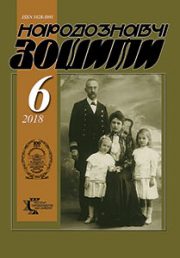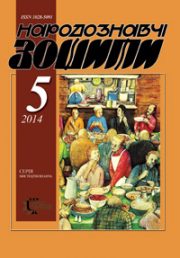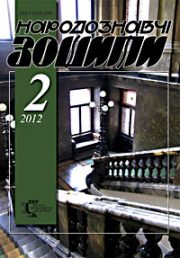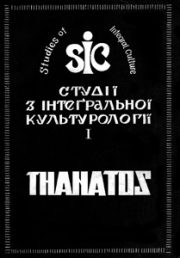The Ethnology Notebooks. 2020. № 1 (151), 190—199
UDK[738:39(=135.2)]:378(478)]:930.2
DOI https://doi.org/10.15407/nz2020.01.190
FRUNZE Olena
ORCID ID: https://orcid.org/0000-0001-5887-2141
Senior lecturer, Postdoctoral student, Head. Department
of Decorative Art and Sculpture, Academy of Music,
Theaterand Fine Arts, active member
of The Union of Plastic Artists from the Republic of Moldova,
87, A. Mateevich st., 2014, Chisinau, Republic of Moldova,
Contacts: e-mail: frunzeelena81@gmail.com
BABINA Yuliana
ORCID ID: https://orcid.org/0000-0001-8717-7092
Postdoctoral student,
The «Ion Creangs» State Pedagogical University of Chisinau,
Kornuluj, 10, MD-2008,
artist-designer JSC Floare-Carpet,
Gradinа botanica, 15, МD-2032,
Chisinau, Republic of Moldova,
Contacts: e-mail: iulianababin1987@yandex.ru
Abstract. Introduction. The Trypillian culture, which originated in the Kyiv, region of Ukraine, is a prominent archeological culture of the Eneolithic period, extending from the Eastern Carpathian to the Middle Dnipro. In the regions of Romania and Moldova, the phenomenon was called the Cucuteni culture. Moldovan ceramics is a bright ethnic artistic phenomenon of a trans-borderline kind of folk art.
Problem Statement. In this study, the authors will try to answer the following questions: when one of the most ancient folk crafts of Bessarabians (including Romanians and Ukrainians) came into existence, when the crystallization of professional pottery as an ethnic phenomenon of trans border art in the territory of Moldova is indicated (which is the object of our research).
Purpose presents what role is played by folk art pedagogical practice at the Academy of Music, Theater and Fine Arts and other institutions of the country, how noticeable are the syncretic responses of the traditional ornament of culture Kukuten-Trypillia in the contemporary decorative art of the Republic of Moldova, to what extent did the Moldovan folk traditions in the works of famous masters adapt at the present stage of the development of pottery art.
Methods. The methodological basis of the study is the principle of historicism, comprehensive, systematic, comparative and retrospective analysis, methods of research of ethnological and additional historical sciences. We consider the semantic and thematic diversity of works, innovative and traditional approaches. We would like to emphasize that the earliest forms of ceramics in the Romania — Moldova — Ukraine region date back to the Eneolithic period and are characterized by a variety of shapes, details and ornaments, such as pottery (a special culture of Cucuteni-Trypillia).
Results. Ancient civilizations (Greece, Rome, Dacia) left behind numerous molds, amphorae, ceramic statuette sinthe Moldavian geographical space, which have a special sophistication.
Conclusion. At the present stage in the Republic of Moldova, pottery does not lose its relevance. Moldavian ceramics can be called an age-old and brilliant ethnic artistic phenomenon of Trans borderline folk art.
Keywords: pottery, folk ceramics, trans-border folk art, ethnic phenomenon, traditions, Trypillian culture, Kukuteni-Trypillia, Ukraine, Bessarabia, Moldova.
Received 5.01.2020
REFERENCES
Frunze, O.M., & Babina, Yu.I. (2019). Cucuteni-Trypillya Culture and Ceramics in the Republic of Moldova: Historiographical Aspects, Intercultural Relations. In: Globalization of Modern Scientific Research 2019. Ivanovo: Scientific world [in Ukrainian].
Buzila, V. (2018). Traditional art from the Republic of Moldova. Chisinau: Neighborhood (Typographic «Bons Offices») [in Romanian].
Khvoyka, V.V. (1901). The Stone Age of the Middle Dnieper. Proceedings of the XI Archaeological Congress in Kyiv in 1899 (Vol. I, p. 12). Moscow [in Russian].
Danilenko, V.M. (1974). Eneolithic of Ukraine (Pp. 10, 25, 29). Kyiv: Naukova dumka [in Russian].
Rybakov, B.A. (1965). Cosmogony and mythology of Eneolithic farmers. Soviet archeology, 1 [in Russian].
Moysey, L.V. (2017). Ornament — Artistic-aesthetic phenomenon: (Ontological and aesthetic visions on the ornamentation of traditional fabrics). Chisinau: Pontos («Good Offices» typography) [in Romanian].
Spynu, C. (2018). Decorative Art from the Moldovan RSS: the years 1944—1991. Inst. Cultural Heritage; Center for the Study of Arts. Chisinau: Epigraph (Typographic «Good Offices») [in Romanian].
Lavrente, I. (2011). Contemporary ceramics from the Republic of Moldova, PhD thesis in the study of arts. Chisinau [in Romanian].
Mytsyk, V. (2004). Who founded the Trypillya culture? Personnel, 10, 63—67 [in Ukrainian].
Miron, S., & Pintilie, E. (2017). Traditional Moldovan folk crafts: From the collections of the National Library. Bibliography of recommendation. Chisinau: National Library of the Republic of Moldova (BNRM editorial —polygraphic center) [in Romanian].
Markevich, V.I. (1981). Late Tripoli tribes of Northern Moldova (Pp. 176—180). Chisinau: Science [in Russian].
Information on 1/1—1947. Moldavian Union of Soviet Artists. Information on the activities of the Union for the Central Committee of the Communist Party of the MSSR. Lists and creative characteristics on members of the Union. Lists of works nominated for the exhibition 1951—1952 [in Russian].
Vasilieva, N., & Ciocolov, S. (2004). 20th century Bessarabian masters, Chisinau [in Romanian].
Sirbu, Gh. (2019). The late Cucuteni-Tripoli communities from the Pruto-Dniester area. Gordineshti cultural group. Doctoral thesis in history. IPC. Chisinau [in Romanian].







